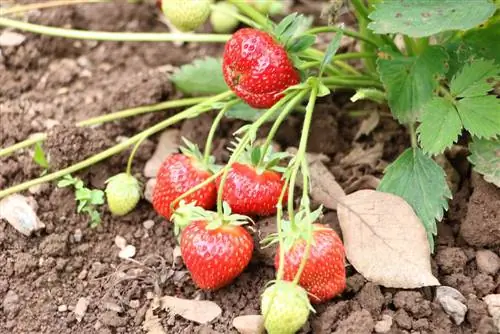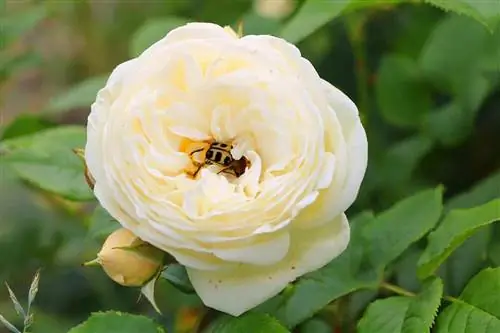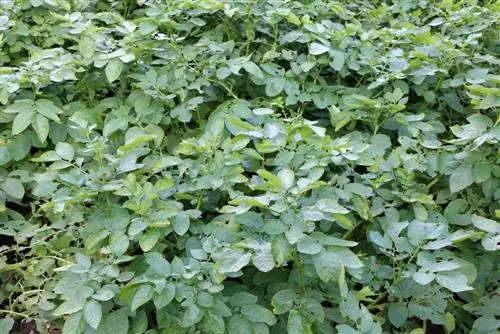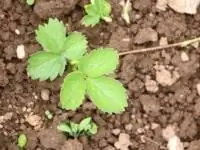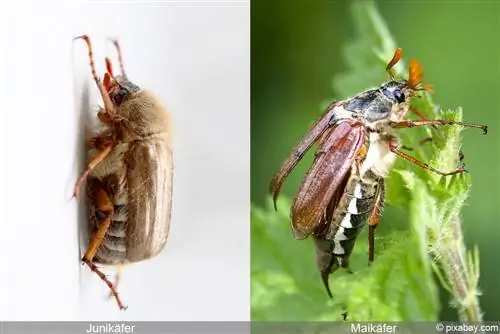- Author admin [email protected].
- Public 2023-12-17 03:39.
- Last modified 2025-01-24 12:45.
When you plant strawberries, you should always be prepared for animal guests who would like to harvest your strawberries. These strawberry pests become a problem if they are not noticed in time and prevented from multiplying.
The following animal pests might like your strawberries. They have been arranged as far as possible according to the possible occurrence of symptoms in the harvest year:
Strawberry Blossom Cutter
The strawberry flower beetle (Anthonomus rubi) starts working on the strawberry flowers. If you notice broken flower buds on your flowering strawberries that dry up and then fall off, it is very likely that the approximately 3 mm small black-brown beetle is at work here, especially if your garden is near a forest. The females lay their eggs in the buds and destroy some of the fruit sets.
The countermeasures are also based on this demeanor and approach: If your garden is near a forest, you should only grow richly flowering strawberry varieties from the outset. The infected flowers are collected and burned to prevent the developing forms from overwintering and thus preventing infestation next year. This has the advantage that nice large fruits will develop on the remaining flowers. As a preventive measure for next year, you should mulch the beds with ferns, and you should also spray the strawberry plants and the soil with tansy extract immediately after harvesting.
If the infestation is very severe, you can also spray a Quassia extract before flowering. If the berries are already blooming, this is only possible again after the harvest. There are some plant protection products with the active ingredient thiacloprid that can be used, but are poisonous to bees. If you decide to use it anyway, you would have to pay close attention to the application description and, above all, observe any waiting times before harvesting.
Common spider mite
This common spider mite (Tetranychus urticae) can also appear quite early in the year, perhaps females (red winter females) have already overwintered on the plant. The population then builds up in spring when temperatures are warmer; warm and dry weather favors their development. The tiny animals (around 0.3 mm) first appear as bright, angular-looking speckles on the top of the leaf, then you will also find the transparent eggs on the lower side. If the infestation is very severe, you can “admire” the different developmental stages of the mites from the egg onwards on the underside of the leaves. They then reveal themselves as the finest webs.
To prevent spider mite infestation, it is recommended to initially plant less sensitive varieties. Restrained nitrogen fertilization in spring should also prevent infestation. If it does happen, predatory mites are said to be a very good help against the pests when they are released on the plants. There is also an approved plant protection product against spider mites, Kiron, with the active ingredient fenpyroximate, but this must not be used during flowering.
Mites and nematodes on strawberries
Infestation with thestrawberry mite (Tarsonemus pallidus) usually becomes noticeable a little later in the year, which is usually noticed by the fact that newly sprouting heart leaves suddenly become heavily curled. These mites are a little smaller than spider mites; at 0.2 mm, they can hardly be seen with the naked eye. Prevention and control are the same as with spider mites.
If your strawberries don't really want to get going, it could also be due to an overpopulation of nematodes. They cause stunted growth, which manifests itself in many ways and can quickly be confused with a mite infestation. The root-feeding nematodes of the genus Pratylenchus are present in every soil, usually together with other nematode genera. They only become harmful when there are too many of them. They then increase the susceptibility of the affected plants to other soil fungi, eat the roots to the point of damaging the plants, and can even migrate completely into the roots and destroy them completely.
Unfortunately, if such damage has already occurred, there is not much you can do; there is no direct method of combating these nematodes. As a preventative measure, you could take a nematode sample from the soil; if the values are elevated, they can usually be reduced by interplanting marigolds.
If you notice cove-shaped feeding marks on the strawberry leaves or the plants show signs of wilting in dry weather and are even easy to pull out of the ground, you will probably find thick beetle larvae in the root area. They are yellowish white, have a brown head, are over 1 cm long and belong to the furrowedbig-mouth weevil (Otiorhychus sulcatus). Maybe later you will come across the black weevil itself, it is a black beetle almost one centimeter long.
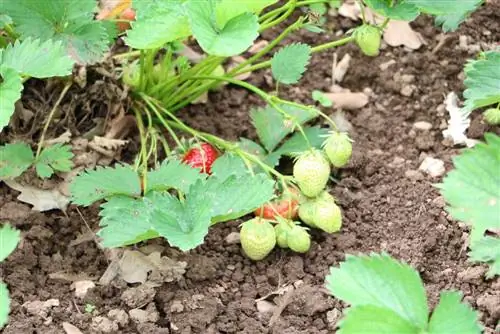
It's not that easy to deal with, it's hard to catch with contact insecticides because it lives very hidden. However, there are several other tricks for combating the black weevil - until you have de alt with these, you should avoid three-year-old strawberry crops and also not grow raspberries on the infested areas.
Root eaters such as wireworms and cockchafer grubs
It would be even worse if the root damage to the strawberries was caused by wireworms. There are no direct means of combating these chitin-armored larvae of theclick beetles (Elateridae), which are up to 3 cm long. Any fight against wireworms quickly degenerates into a campaign with a bundle of measures. It is therefore recommended that you never grow strawberries or vegetables directly on a freshly plowed meadow because the soil is usually riddled with wireworms.
Cockchafer grubs (Melolontha melolontha) could also be responsible for the root damage, which could be noticeable through wilting and even the death of the entire plant. If you are unlucky enough that the grubs, which grow in the ground for up to five years, have chosen your garden as a nursery, you will probably notice this by looking after other plants. However, this is not very likely unless you have just planted a freshly cultivated natural meadow (see wireworms) or your property is located in a forest or next to a park. If you are one of the victims, it will be stressful again because the grubs have to be combated through a whole package of measures.
If your well-grown strawberries are really getting tough in the upper area, perhaps even the fruits have been nibbled with a clear appetite, snails could still have an appetite, which you could counteract with slug pellets in an acute case But there are also several preventive measures.
Other strawberry diseases
If the leaves and fruits of the strawberries do not look as they should, bacteria and fungi can be to blame, e.g. B. theAngular leaf spot, caused by the bacterium (Xanthomonas fragariae), thegray rot caused by the fungus(Botrytis cinerea) or theGnomonia fruit rot, which is caused by a fungus called Gnomonia fructicola.
Other strawberry fungi are known under the namesStrawberry mildew(Sphaerotheca macularis),Rhizome rotorLeatherberry rot, caused by the same fungus on different parts of the strawberry (Phytophthora cactorum),Red root rot(Phytophthora fragariae),Verticillium wilt(Verticillium albo atrum, Verticillium dahliae),Anthracnose(Colletotrichum acutatum),White spot(Mycosphaerella fragariae) andRed spot (Diplocarpon earliana).
Each fungus needs to be combated specifically, with the exception of black root rot, in which various fungi, nematodes and bacteria are involved. There's usually not much that can be done to combat them; the most promising measures are thorough soil care and the introduction of other plants.
If your strawberry fruits have brown, ugly and watery spots, you can't find any animals in or on the earth with the best will in the world and there is no smell of any fungi at all, it could well be that they don't have them at all are sick. But simply suffer from sunburn - yes, that also happens with strawberries! You should therefore always ensure that the fruits are not exposed to direct sunlight. You can prevent this by planting in a north-south direction; on hot, sunny days you can cool the strawberries with intermittent watering, which also refracts the light, or by placing hail protection nets.

